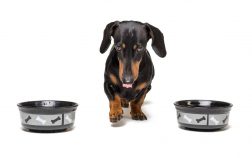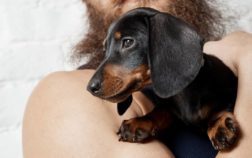Dachshund ears losing hair is a common problem amongst this popular family pet, and it can be a big worry for many dachshund owners! Let’s find out everything you need to know about the causes and treatments for dachshund ears losing hair.
Why Is My Dachshund Losing Hair On His Ears?
Let’s face it, one of the most adorable features of the dachshund is their long, floppy ears! Along with their stumpy legs and long bodies, the ears of the dachshund are one of the most recognizable aspects of this much-loved breed.
But unfortunately, these long floppy ears come with a whole host of different problems! Dachshund ears losing hair is all too common and can be a life-long issue with no cure.
Some dachshund ear problems can be incredibly uncomfortable for the dog, while others just cause cosmetic unsightliness due to hair loss.
Let’s take a look at the most common reason for dachshund ears losing hair!

Dachshund Ears Losing Hair – Is Pinnal Alopecia To Blame?
If your dachshund starts to lose hair on the ears without any other symptoms, then pinnal alopecia may well be the cause.
Pinnal alopecia, or pattern baldness, is a condition where the dog loses hair on the ears, but no other side effects are seen. It is considered to be a cosmetic condition that does not cause discomfort to the dog, but it is important to ask your veterinarian to rule out any other ear problems.
When a dog has pinnal alopecia, it will lose hair in the same pattern on both ears. It normally starts when the dog is around six months of age, and it thought to be hereditary. The hair loss continues throughout the dog’s life, and many dogs with this condition will have completely bald ears by the age of eight or nine.
In some cases, pinnal alopecia also causes the skin to darken in patches on the ears. It may also spread to other areas on the body, although this is uncommon.
Is It Common For Dachshunds To Get Ear Infections?
The size and shape of the ears of a dachshund make it prone to developing ear infections. This is because the ears hang down over the ear canal, preventing air from circulating freely.
In dogs with floppy ears, the ear canal can become moist and a build-up of bacteria can occur. This can potentially lead to ear infections, particularly in breeds such as the dachshund.
The other problem with the dachshund is that they are very low to the ground! This makes it easier for dirt and debris to enter the ear canal, particularly grass seeds. It also means that parasites that lurk in longer grasses find it easier to hitch a ride on a passing ear!
Dogs with ear infections will experience significant discomfort, and will scratch at the ear in an attempt to alleviate this. In severe cases, this can lead to hair loss on the ears, as well as inflammations and skin lesions.
What Does It Look Like When A Dog Has Ear Mites?
Ear mites in dogs are incredibly small, and they can be difficult to spot with the naked eye. However, there are some other tell-tale signs that can indicate that a dog is suffering from ear mites.
These tiny mites cause intense itching and irritation, and your dog will scratch at its ears in an attempt to relive any discomfort. This can lead to skin irritation and baldness around the ears.
Dogs with ear mites often also develop a build-up of dark, waxy discharge inside the ear canal, which has a strong, foul odor. The ears can become sore and inflamed, and your dog may resent any attempts to clean the ears.
To confirm a diagnosis of ear mites, your veterinarian will look down the ear canal with a specialist tool called an otoscope. This magnifies and illuminates the ear canal, making ear mites and other problems easier to spot. It may also be necessary to take a swab from the ear canal, to be examined under a microscope.
How Do You Treat Ear Margin Dermatosis?
Ear margin dermatosis is a skin condition that commonly affect dachshunds and other dog breeds with long, pendulous ears. You may also hear this condition referred to as ear margin seborrhea, and the cause of this condition is unknown.

Ear margin seborrhea causes skin changes to the margins of the ear, where plugs of hair fall out to reveal shiny lesions underneath. In severe cases, these can become reddened and inflamed.
How To Keep Your Dachshund’s Ears Healthy
It is important to check your dachshund’s ears regularly in order to quickly identify any problems. Once a day, lift up those floppy ears and take a peek inside the ear canal – it should be clean, dry, and free from odors.
Any dirt around the outer section of the ear canal can be gently wiped away using cotton wool balls and warm water. If this is a persistent problem, your veterinarian may be able to recommend an effective dog ear cleaning solution.
For dachshunds, grass seeds in the ears can be a particular problem. Keep the ears well-groomed and pick off any grass seeds as you find them.
Summary – Dachshund Ears Losing Hair

So, as we have learned, dachshund ears losing hair can occur for a range of different reasons. Some of these just cause cosmetic hair loss, such as pinnal alopecia or hereditary pattern baldness. Other ear problems can cause significant discomfort, including ear mites and ear margin dermatosis. Dachshunds are particularly prone to ear problems due to poor air circulation around the ear canal.
We’d love to hear your thoughts on the causes of dachshund ears losing hair! Does your little dachshund suffer from skin problems around his ears no matter what you do? Or maybe you’ve got some questions about the best way to keep your dachshund’s ears in good condition? Leave a comment below and we will get back to you!




